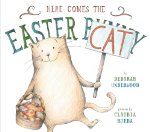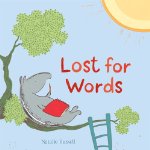I love picture books that feature strong, sassy, and determined characters. Cat, who appears in today's picture book, is just such a character. He knows what he wants, and he sets out to get it, in his own funny and distinctive way.
 Here comes the Easter Cat
Here comes the Easter Cat
 Here comes the Easter Cat
Here comes the Easter Cat
Deborah Underwood
Illustrated by Claudia Rueda
Picture Book
For ages 5 to 7
Penguin, 2014, 978-0-8037-3939-0
Cat is in a bad mood. When he has asked why, he holds up
a sign and on it there is a picture of the Easter Bunny. Cat is not pleased at
all that everyone loves the Easter Bunny and does not understand why a rabbit
is so beloved. Cat is told that the Easter Bunny is “nice” and he “delivers
chocolate eggs to millions of kids.”
Unfortunately, Cat
starts to feel jealous. It is suggested that he should set aside his negative
feelings. Instead, he should become the Easter Cat. Why not? A cat can be nice
to children too, surely.
Cat suggests
bringing children hairballs, but that idea is shot down pretty swiftly. Cat
then has to consider how he is going to get around. He cannot hop like the
Easter Bunny. Being a hip feline, Cat decides that he will ride a motorcycle.
He also chooses a rather snazzy outfit to wear. Then Cat learns something that
horrifies him. The Easter Bunny doesn’t get to have naps! How can anyone
survive if they don’t have several naps every day? Perhaps Cat isn’t cut out to
be the Easter Cat after all.
With wonderfully
expressive artwork and amusing interactions between Cat and an unseen person
who is talking to Cat, this picture book gives readers a book experience that
will make them laugh and that will also charm them with its understated
sweetness.







